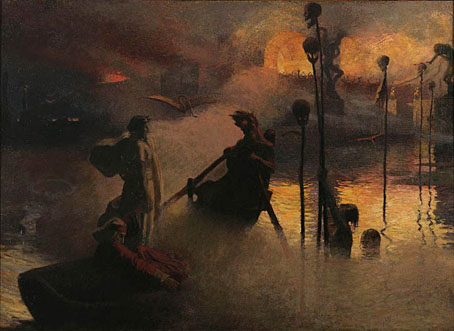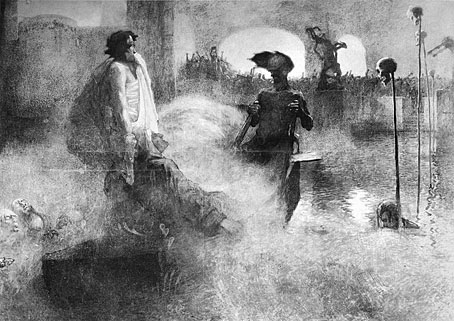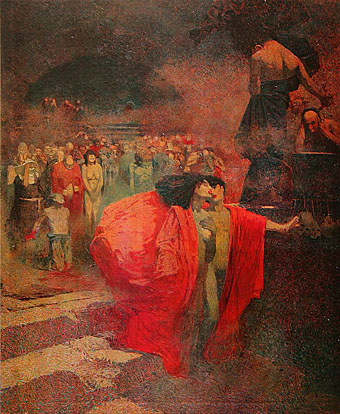
Mirko Racki (1879–1982) was a Croatian painter whose early work fits the template of allegorical Symbolism even if he was never part of any Symbolist movement. Dante’s Divine Comedy was a favourite subject: these canvases are among the available examples which also include a series of etchings. The painting above showing Charon ferrying Dante and Virgil across the Styx struck me for being closer to Wayne Barlowe’s more recent depictions of Hell than the kinds of infernal imagery you’d expect from the early years of the 20th century. This quality, which you find in other artists from Eastern Europe, may be a result of the Academy being less of a dominant force than it was in Western European countries. It’s still the western artists that dominate the web, however, so details about Racki’s work are scant. The third painting shows Paolo and Francesca being sent to the second circle of the Inferno. (Racki tip via Beautiful Century.)


Previously on { feuilleton }
• Albert Goodwin’s fantasies
• Harry Lachman’s Inferno
• Maps of the Inferno
• A TV Dante by Tom Phillips and Peter Greenaway
• The last circle of the Inferno

Hi John, You may have already seen this (I saw it as part of a Channel 4 animation season quite a while back) but if you haven’t
you may find this amusing:
https://www.youtube.com/watch?v=VQWuw7UNwG0
Those dates are correct? Wow how the world changed during his lifetime! He was entering middle age when the Soviet Union came into being and damn near made it to the end.
But all this reminds me how blinkered we are here in the States. Europe is Britain, France and Germany with the occasional news from Italy or Greece when something bad happens. You’d think Germany and Russia shared a frontier! No consciousness that such an entity as “eastern europe” even exists.
Modzilla: Thanks, if I did see that before it’s not one that I remember.
Stephen: Europe isn’t so big geographically but the differences between countries can be striking. I’ve always been fascinated by the way that travelling east increases the influence from the Middle East (in music especially) until you reach Turkey and you’re midway between two cultures. There’s a definite cultural shift whatever direction you travel: Scandanavian art is very different to that of the Mediterranean nations. And Spain, of course, has a long history of African/Islamic influence in its southern regions.